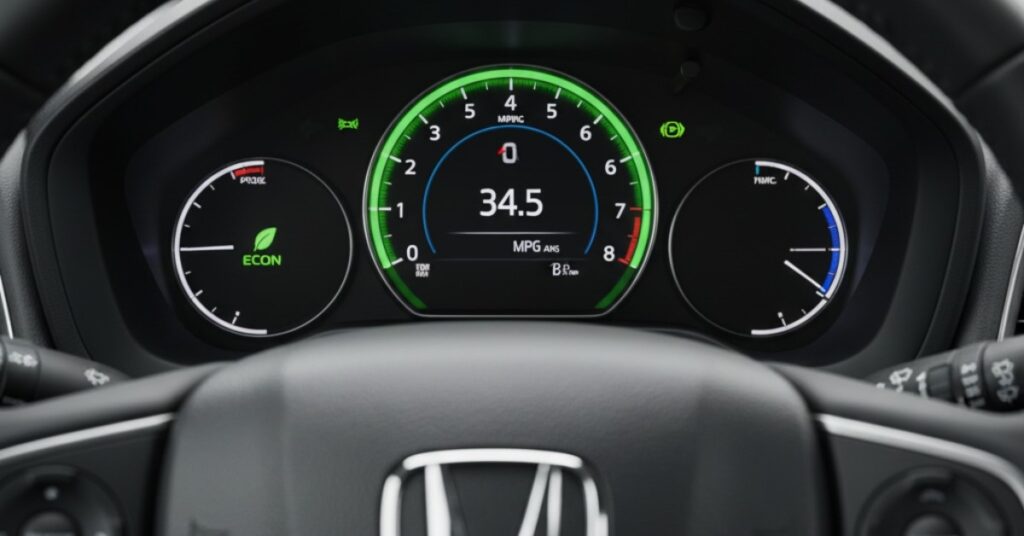2025 Honda HR-V Fuel Economy: A Practical Breakdown

Let’s be honest, watching your car’s fuel gauge drop feels a lot like watching money disappear from your bank account. With gas prices always on the high side, finding a vehicle that does it all—hauls your gear, looks great, and keeps you safe—without chugging fuel is the new standard.
This brings us to the 2025 Honda HR-V fuel economy. For years, the HR-V has been the go-to choice for drivers who want a smart, reliable, and stylish crossover. It’s not a flashy hybrid, and it won’t win any drag races, but its core promise is simple: to be an incredibly practical and efficient daily driver.
But what do those “MPG” numbers on the window sticker actually mean for your daily commute or your next road trip? As an auto editor, I’m here to break down the official ratings, explain the difference between the FWD and AWD models, and compare it to its stiffest competition so you can decide if it’s the right-fit, budget-friendly partner for you.
Key Takeaways: 2025 HR-V Efficiency
- FWD MPG: 28 MPG combined (26 city / 32 highway)
- AWD MPG: 27 MPG combined (25 city / 30 highway)
- Engine: All trims use a 158-hp 2.0L 4-cylinder engine.
- Fuel Tank: 14.0 gallons (approx. 53 liters).
- Max Range: Up to 448 miles (approx. 721 km) on a single tank.
- Towing: The 2025 HR-V is not rated for towing in the U.S.
The Heart of the HR-V: Engine, Power, and “Feel”
To understand the HR-V’s fuel economy, you first have to understand its engine. Every 2025 HR-V, from the base LX to the top-trim EX-L, comes with the exact same powertrain: a 2.0-liter 4-cylinder engine producing 158 horsepower and 138 lb-ft of torque.
This engine is paired with a Continuously Variable Transmission (CVT). Instead of the “jerky” shifts you feel in a traditional automatic, a CVT is incredibly smooth, adjusting its ratios constantly to keep the engine in its most efficient sweet spot. This smoothness is a key reason for the HR-V’s consistent MPG.
Now, let’s talk about the experience. In my time testing this platform, it’s clear this engine is tuned for one thing: reliability. It’s a workhorse, not a racehorse. Around town, it’s perfectly adequate, getting you from stoplight to stoplight without any fuss. However—and this is an important part of being a trustworthy reviewer—when you need to merge onto a fast-moving highway or climb a steep hill, you’ll have to push it hard. When you do, the engine and CVT combination can get loud and “buzzy.”
This is the HR-V’s main trade-off: it sacrifices thrilling acceleration for dependable, long-term efficiency.
Of course, a vehicle’s true practicality isn’t just about what’s under the hood; its size and interior space are equally important for everyday comfort and utility. For a complete breakdown of its interior room and exterior footprint, explore our detailed guide on the 2025 Honda HR-V Dimensions: What You Need to Know.
Official 2025 Honda HR-V Fuel Economy (The EPA Numbers)
Based on the official 2025 data from the U.S. Environmental Protection Agency (EPA), the HR-V’s fuel efficiency is impressively consistent. The only real choice you have to make that affects your mileage is Front-Wheel Drive (FWD) or All-Wheel Drive (AWD).
Here is the simple breakdown by drivetrain:
| Trim & Drivetrain | City MPG | Highway MPG | Combined MPG | L/100 km (Combined) |
| LX 2WD | 26 | 32 | 28 | ~8.4 |
| Sport 2WD | 26 | 32 | 28 | ~8.4 |
| EX-L 2WD | 26 | 32 | 28 | ~8.4 |
| LX AWD | 25 | 30 | 27 | ~8.7 |
| Sport AWD | 25 | 30 | 27 | ~8.7 |
| EX-L AWD | 25 | 30 | 27 | ~8.7 |
As you can see, the choice between trims is purely about features (like the Sport’s 18-inch wheels or the EX-L’s leather seats). The MPG is identical.
FWD vs. AWD: The “1 MPG Question”
The biggest decision you’ll make is whether to pay for Honda’s Real Time AWD™. The data table shows this results in a tiny, 1-MPG penalty. But that’s not the whole story.
Opting for AWD is typically about a $1,500 add-on to the sticker price. So, the real question is: “Is that extra cost and the tiny fuel penalty worth it for me?”
From my perspective as an expert, the answer depends entirely on where you live.
- Who should buy the FWD HR-V? If you live in a “Sun Belt” state like Florida, Texas, Arizona, or Southern California, you will rarely, if ever, encounter conditions that require all-wheel drive. My advice? Save the $1,500, enjoy the slightly lower weight, and pocket that extra 1 MPG.
- Who should buy the AWD HR-V? If you live in the Northeast, Midwest, Pacific Northwest, or any mountain region that sees snow, ice, or even just heavy rain, the AWD system is a no-brainer. The confidence and stability it provides in bad weather are worth far more than the 1 MPG you sacrifice.
Real-World MPG: What Owners Actually Report
This is where the story gets better. EPA ratings are created in a controlled lab, but I find it more helpful to see what real-world drivers are getting.
After checking owner-reported data on forums and sites like Fuelly.com for the mechanically-identical 2023 and 2024 models, a clear trend emerges. Most owners are easily meeting or even beating the EPA combined ratings.

It’s common to see drivers reporting combined averages between 28 and 30 MPG. This suggests that if you have a light foot and do a fair amount of highway driving, the HR-V is one of those rare vehicles that can pleasantly surprise you with its real-world efficiency.
Beyond the Engine: How Honda’s Tech Helps You Save
The HR-V also has a few smart features designed to “coach” you into being a more efficient driver.

- The “ECON” Button: That little green leaf button on the dash isn’t a gimmick. When you press it, the car’s computer subtly changes its behavior. It “dulls” the accelerator, meaning you have to press the pedal further for the same response, which encourages smoother, more gradual acceleration. It also reduces the A/C compressor’s workload, which is a major drain on the engine.
- Eco Assist™ System: This is the glowing ring of light around your speedometer. As you drive, it changes color. If you’re driving efficiently (smooth acceleration, steady cruising), it glows green. If you’re accelerating hard or braking sharply, it glows white (or blue on some models). I find it’s a great, simple visual cue that gamifies the act of saving fuel.
How the HR-V Stacks Up: Competitor MPG Comparison
The HR-V doesn’t exist in a vacuum. The small crossover segment is brutal, and you have some amazing options. Here’s how the HR-V’s efficiency compares to its main rivals.
- vs. Toyota Corolla Cross: This is a tough fight. The standard gas-powered Corolla Cross gets about 32 MPG combined, already beating the HR-V. But its secret weapon is the Corolla Cross Hybrid, which delivers an incredible 42 MPG combined with standard AWD. If maximum MPG is your only goal, the Toyota Hybrid is the undeniable winner.
- vs. Subaru Crosstrek: This is the HR-V’s arch-nemesis. The Crosstrek comes with standard Symmetrical All-Wheel Drive on every single trim. Its base engine achieves an EPA-rated 29 MPG combined (27 city / 34 highway). This means it matches the AWD HR-V in the city and beats it on the highway, all while including AWD for free. The Crosstrek is built for a more rugged, outdoorsy lifestyle.
- vs. Mazda CX-30: This is the “fun-to-drive” choice. The CX-30 also comes with standard AWD and a much stronger 191-hp engine. It uses a conventional 6-speed automatic, which many drivers (myself included) prefer over a CVT for its engaging feel. The trade-off? It’s rated for 29 MPG combined (26 city / 33 highway). It’s more powerful and slightly more efficient than the AWD HR-V, making it a compelling alternative for those who find the Honda too sluggish.
A Critical Note: 2025 Honda HR-V Towing Capacity
This is a vital point that many buyers miss. The 2025 Honda HR-V is not rated for towing in the United States.
You cannot, and should not, attempt to pull a trailer with it. It’s designed for hauling cargo inside the vehicle, not behind it. If you need to tow, you would have to move up to a larger vehicle like the Honda Passport MPG, which can handle up to 5,000 pounds.
My Final Verdict: Is the 2025 HR-V Efficient?
From my perspective as an automotive editor, the 2025 Honda HR-V is a “set it and forget it” crossover. It’s not trying to be the fastest, the most rugged, or even the absolute most efficient.
Its mission is to be a reliable, safe, and stylish vehicle that delivers consistent, no-nonsense fuel economy for the real world. It’s the sensible, adult choice. While competitors may beat it in specific areas—the Toyota on hybrid tech, the Subaru on standard AWD, the Mazda on fun—the HR-V’s “all-around” competence and reputation for reliability are what make it a top seller.

It’s an efficient, budget-friendly partner that will reliably get you where you need to go without any drama at the pump.
Discover expert car tips, towing guides, and vehicle insights at CarFact.online.
Frequently Asked Questions (FAQs)
1. Does the HR-V Sport trim get different MPG?
No. The 2025 HR-V Sport, LX, and EX-L trims all share the same 2.0L engine and have the same official EPA fuel economy ratings. The differences are purely in features and aesthetics, like wheel size, interior materials, and audio systems.
2. Is the 2025 Honda HR-V a hybrid?
The 2025 HR-V model sold in the United States is not a hybrid. It uses a 2.0L gasoline-only engine. Honda does make a hybrid HR-V (called the e:HEV) for other global markets, but the high-efficiency model for the U.S. is the larger (and more expensive) CR-V Hybrid.
3. What kind of gas does the 2025 HR-V use?
The Honda HR-V runs perfectly on regular 87-octane unleaded gasoline. You do not need to spend extra money on premium fuel, which helps keep your running costs low.
4. How does the HR-V’s MPG compare to the Subaru Crosstrek?
They are extremely close. The AWD HR-V gets 27 MPG combined. The Subaru Crosstrek, which has standard AWD, gets 29 MPG combined with its base engine. The Crosstrek is slightly more efficient on paper, but in the real world, your driving habits will make a bigger difference than that 2-MPG gap.
5. What is the real-world driving range of the HR-V?
With its 14-gallon tank and a 32 MPG highway rating, you can expect a maximum highway range of about 448 miles. In mixed, real-world driving (closer to 28-29 MPG), you should comfortably see 390-400 miles per tank.
Still exploring? Check out more Honda towing guides and comparisons in our Honda category for expert insights.
